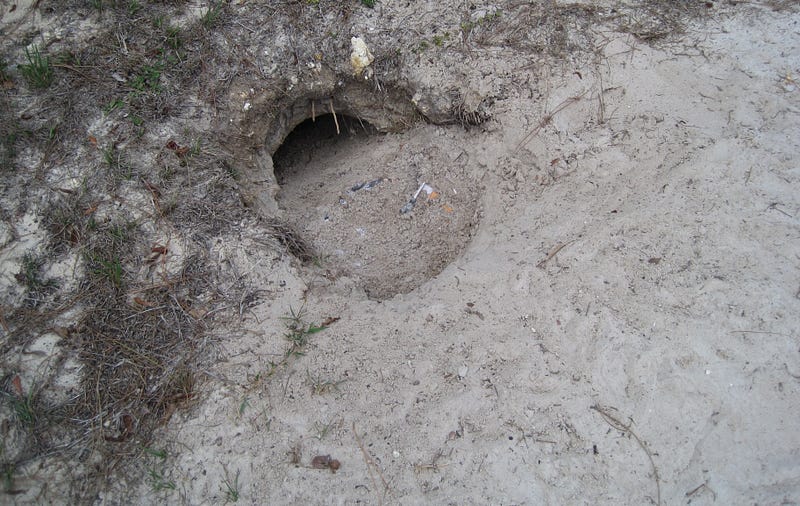The commensalism story for this week is about one of my favorite species outside of sea turtles: the gopher tortoise, Gophereus polyphemus. At first glance, it might appear to be a fairly unremarkable and nondescript terrestrial turtle. However, this somewhat drab species is actually an animal engineer.
As you might imagine from the name, this tortoise’s claim to fame is burrowing. Those hefty front legs and claws are no good for swimming, but excellent for digging. A gopher tortoise burrow can reach over 14 meters long and 3 meters deep and an individual will usually dig several burrows within their home range.

The burrows help shield their inhabitants from heat, cold, fire, and predators. These benefits are substantial, and the gopher tortoise isn’t the only species that will take advantage of them. Gopher tortoises are referred to as a ‘keystone species’, because their effect on the ecosystem is high relative to its overall abundance. The term comes from the concept of a keystone in an arch. Removal or reduction of a keystone species can have far-ranging consequences. Everything is connected, but the connections to a keystone species are even more important than for others.
The gopher tortoise is a keystone species because of its commensal relationship with hundreds of other species in the pine uplands where they are most often found (though the tortoises also live in beach dune habitats). These include a variety of reptiles, amphibians, mammals, birds, and numerous invertebrates. Among them are species of special conservation concern, such as the eastern indigo snake, Drymarchon couperi, and the Florida burrowing owl, Athene cunicularia floridana.

Unlike the remora, there is less uncertainly about the commensal nature of these relationships. As I mentioned before, gopher tortoises will usually dig multiple burrows in their small (4 acres on average) home range. Not all of these burrows will always be in use. Many gopher tortoise burrows are abandoned by their creator and other animals can take up residence. Because of this, the tortoise is not negatively or positively affected by the presence of these other species in burrows it has dug and those individuals receive a tangible benefit. This commensal relationship is similar in some regards to the hermit crab, which uses empty shells of dead snails for protection.

Unfortunately, desirable gopher tortoise habitat tends to overlap with desirable people habitat. In Florida, a few feet in elevation can mean the difference between dry soils and a marsh or swamp. It’s a lot harder to build houses on the latter, but it’s impossible to dig burrows. Gopher tortoises need dry soil in order to live. The burrow is an integral part of their temperature regulation requirements. The females also lay their eggs directly in front of the burrow entrance, an area known as the apron. Because of habitat loss and other pressures, gopher tortoises are now considered a threatened species.
Losing the gopher tortoise would be bad enough. However, the commensal relationships that have developed around it mean that a broader effect would be certain. Many of the animals that use gopher tortoise burrows cannot dig efficiently themselves. A snake, lizard, or frog does not have the equipment for such work. Therefore, eliminating the gopher tortoise from the environment could potentially lead to cascading problems or even ecosystem collapse, just as if someone had removed the keystone from an arch: the entire structure crumbles. One of the reasons why I share these stories with you is to spread awareness and hopefully prevent something like that from happening in the future.

So far, most of my symbiosis stories have involved animals. This isn’t that surprising considering my interests and scientific background. However, it wouldn’t be right to completely ignore the flora this season, so next week’s story will be exclusively about plants.